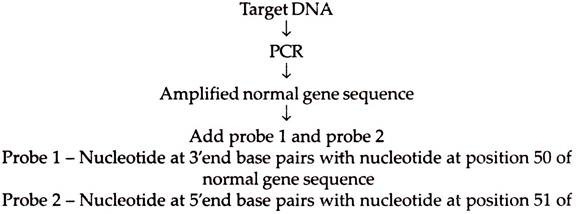Polymerase Chain Reaction-Oligonucleotide Ligation Assay (PCR-OLA) is a method to diagnose hereditary diseases caused by mutation not affecting restriction endonuclease sites.
This method combines Polymerase Chain Reaction with the Ligation Assay. PCR-OLA distinguishes between the ligation and the absence of ligation of two oligonucleotides. A single nucleotide mismatch (at the site of hybridized oligonucleotides) prevents ligation and hence we can distinguish between the wild and mutant genotype. PCR-OLA can be understood with the help of an example. PCR-OLA is a sensitive, rapid and highly specific method.
Assume that in:
Normal gene sequence – say at position 50, nucleotide pair is A:T
Mutant gene sequence – say at position 50, nucleotide pair is G:C
We are aware of the nucleotides on both sides of position 50. Therefore, we synthesize two oligonucleotide sequences which are complementary to normal and mutant gene sequence (one of the two native strands). These two oligonucleotide sequences will act as probe. One of the oligonucleotide sequences, say probe 1, is labeled at its 5’end with biotin (B) and its 3’end has nucleotide Adenine, A (nucleotide complementary to position 50 in the normal gene sequence).
Another oligonucleotide, say probe 2, is labeled at its 3’end with digoxigenin (D, an antibody binding indicator) and its 5’end has nucleotide complementary to position 51 (adjacent to mutated nucleotide) in the mutant gene sequence, say cytosine (C).

